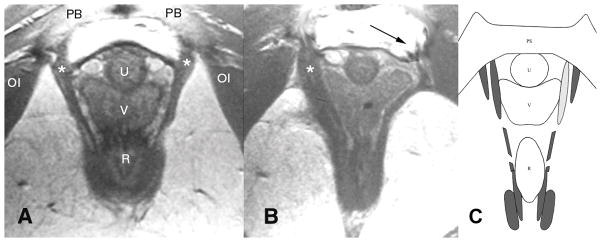Figure 4.
(a) Normal anatomy in an axial mid-urethra proton density magnetic resonance image that shows the normal pubovisceral muscle(shown by the asterisks). (b) Woman who has lost a part of the left pubovisceral muscle (displayed on the right side of the image, according to standard medical imaging convention), with lateral displacement of the vagina into the area normally occupied by the muscle. The arrow points to the expected location of the missing muscle. (c) Axial, mid-urethral section through the arch of the pubic bone (see pubic symphysis (PS), top) and the model levator ani muscles corresponding to those from the patient shown in (b). Intact muscles are shown in dark gray. The location of simulated muscle atrophy is illustrated by the light gray shading of the left-hand pubovisceral muscle. This location is shown to correspond with the location of muscle atrophy demonstrated in (b). OI: obturator internus; PB: pubic bone; U: urethra; V: vagina; R: rectum. Modified from Reference 10.

